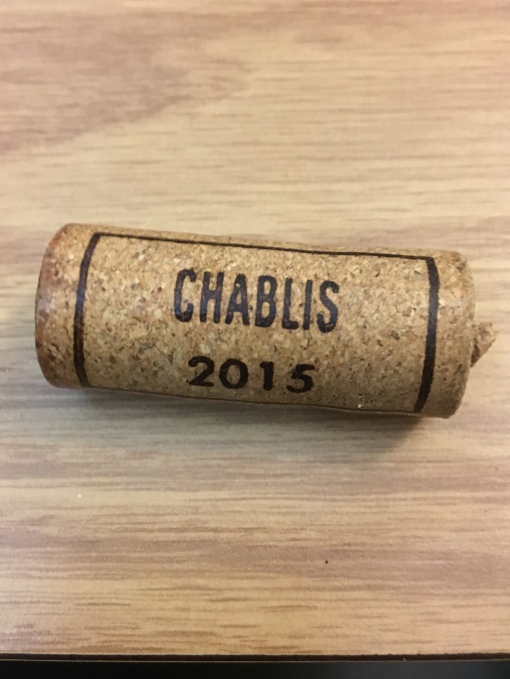By Raymond Lamontagne
After last night’s quirky yet mightily delicious Rioja, I’ve got the distinct feeling that this weekend run of three wines is going to deliver fireworks. Lo and behold, today’s reveal is a Chablis from one of the best known, most emblematic producers in the region. Burgundy remains my favourite wine region despite many strong contenders. And Chablis, that northern Burgundian outpost of stark minerality and abject crystalline purity, is a particularly singular wine region unto itself. Plagued by viticultural hazards, including regular springtime frosts and the odd unpredictable hailstorm, grape growing is no easy task in this hinterland. I continue to marvel at exactly how these hard-working vintners can distill these harsh conditions into such sheer, stony, precise, pixelated and elegant wines. They are known for a distinctive “gunflint” note, described as “goût de pierre à fusil“, or “steely” if you prefer something rather less martial. ‘Minerality” remains hard to definitively pin down as a construct. We have to date identified no specific “mineral” receptors in the human gustatory system, and yet one cannot reasonably deny the existence of such aromas in certain wines. I’ve even heard the argument that Chablis is where Chardonnay shines most brightly, its true spiritual home. The notion that this grape’s genuine essence could be more ethereal mineral than gaudy fruit intrigues me to no end, subjective viewpoint though it may be.

William Fevre began with the 1959 harvest, although William’s father Maurice was growing grapes back in the 1930s, mainly in Chablis’ Grand Cru vineyards. Today William Fevre owns the largest number of Grand and Premier Cru vineyards in the region, populated mostly by old, low-yielding vines. The estate was purchased by the Henriot family of Champagne in 1998. Although such a takeover can sometimes be a harbinger of decreased quality, the Henriots instead implemented a new philosophy geared towards better preservation of the nuances of Chablis terroir: use of new oak was abolished in favour of old barrels with an average age of 6 years. Grapes are grown organically, although the estate isn’t particularly fussy about getting official certification. William Fevre seeks to preserve even the most muted variations across individual sites. This focus is coupled with an emphasis on “instant appeal” in the wines, one of those ideological melds of tradition and avant-garde technology that works, and works well.

The 2015 vintage in Chablis was characterized by a late onset of winter, with some frost and rain until the end of May followed by hot, dry weather at the start of June until the end of August. This is pretty optimal for the Petit Chablis and (non-Cru) Chablis vineyards, lesser sites where grapes can struggle to reach an appropriate degree of ripeness. Indeed, the fine folks at Bricks chose well here. According to William Fevre cellarmaster Didier Seguier, “It’s a perfect vintage for the lower appellations, Petit Chablis and Chablis… These can be difficult in cool, late years, but in ’15 they have a good level of ripeness and freshness.” The entry level Chablis AOC profiled here is harvested manually, with the grapes receiving a brief, gentle pneumatic press followed by gravity settling of the juice. Some fine lees is retained, and the wine does undergo malolactic fermentation (many basic Chablis do not, although I believe the practice has become more common in the region of late). Maturation occurs only in stainless steel.

Cork Rating: 3.0/10 (Points for total and utter clarity as to region and vintage. Alas, there is little else to score here.)
This all sounds textbook. Frankly, that’s exactly what I am expecting here, in the very best way. I am not disappointed. The fruits include tart Granny Smith apple and the most stern and austere of the green pears, followed by some suggestions of under-ripe hard nectarine, lemon and watermelon rinds (you know, that watery white stuff), a few ghosts of pineapple and starfruit. White berries do occur in nature (e.g. the snowberry) but they are largely unpalatable. If one were indeed edible, I feel I would detect such a note in this taut, precise little dynamo. A pleasing minerality of matchlock musket, chalkboards, and Epsom salts begins to billow from the glass, and I welcome more associations of green banana peel, salted cultured butter, margarita glass rim, and Siberian peashrub/caragana flowers (let’s go with “acacia” for those of you following along on a tasting wheel). The fresh acid is far from meek, malo notwithstanding, and the finish recalls an abrupt sharp slap followed by a few conciliatory caresses. This aggression will not stand, man. Truth be told, this is far too classy to merit more than a few allusions to anything truly bellicose.
89+ points


Leave a comment